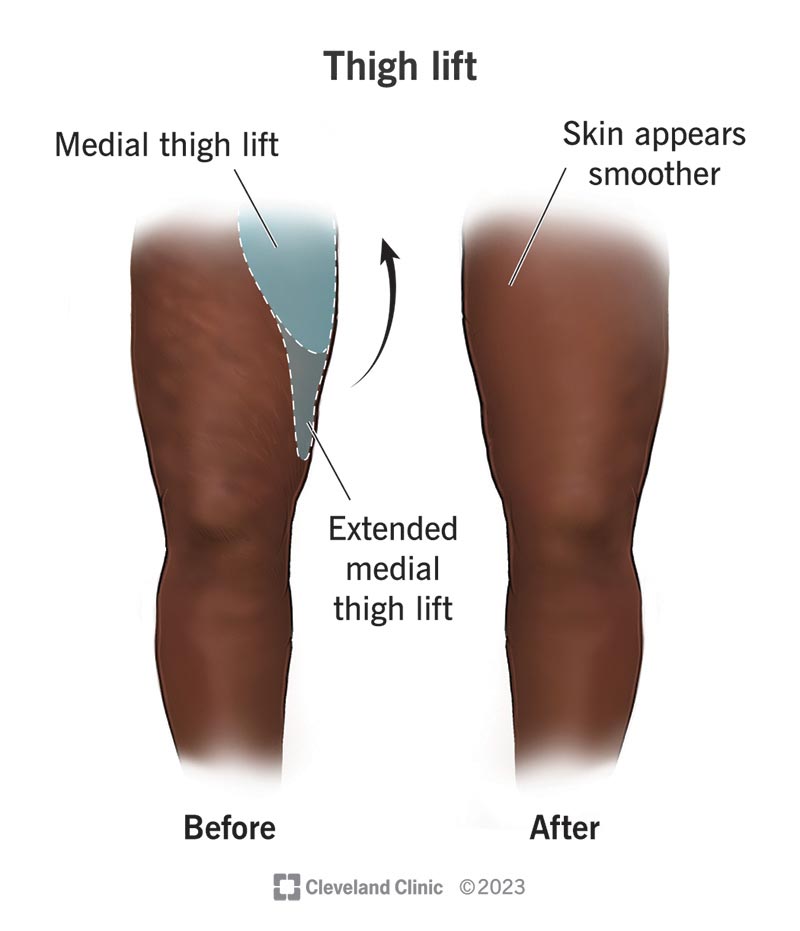A thigh lift (thighplasty) is a cosmetic procedure that can improve the contours and tone of your thighs. This surgery works by removing excess fat and sagging skin. You may choose to get a thigh lift if you’ve lost a lot of weight. You should see the full results of your thigh lift after six months.

A thigh lift (thighplasty) is a cosmetic surgery that removes excess skin and fat, reshaping your thighs to give you a more contoured appearance. It also relieves pain and irritation that occurs when your thighs continuously rub against each other.
You may consider getting a thigh lift procedure if you lose a significant amount of weight. Major weight loss can lead to poor skin tone and loss of elasticity in areas that store excess fat, like your thighs. This can cause:
You may be a candidate for thigh lift surgery if you:
A surgeon will evaluate whether you’re a candidate for a thigh lift procedure by checking your general health and medical history.
Plastic surgeons performed over 9,000 thigh lift procedures in 2020 in the United States according to the American Society of Plastic Surgeons.
Cleveland Clinic is a non-profit academic medical center. Advertising on our site helps support our mission. We do not endorse non-Cleveland Clinic products or services. Policy
Before your surgery, you’ll meet with your plastic surgeon, who’ll go over the procedure with you and answer any questions. During this consultation, your surgeon will examine your skin, learn about your goals and expected outcome, and let you know about possible side effects. Your surgeon may take pictures of your thighs to compare before and after results.
Your surgeon will give you specific instructions on how you can prepare for surgery, which may include taking certain medications or stopping smoking.
A thigh lift takes place in a hospital, accredited in-office surgical facility or ambulatory surgery center.
On the day of your surgery, here’s what to expect:
You’ll have scars from a thigh lift on the location of the incision or area where your surgeon cut your skin. The incision location and size depend on which part of your thigh you wish to target. Options include:
Thigh lift surgery may take two hours to complete. Your surgeon will go over the time estimate with you during your consultation.
You may choose to get more than just one cosmetic procedure done at the same time as a thigh lift. It’s common for people to also receive a butt lift or a lower body lift while they’re getting a thigh lift done. Your surgeon will let you know if it’s possible to combine different procedures to meet your goals.
After a thigh lift surgery, you’ll move to a recovery area until you wake up from general anesthesia. You may need to stay in the hospital after your surgery, or your surgeon will allow you to go home on the same day. You should plan to have someone drive you home after your surgery.
Your surgeon will give you instructions on how to care for your surgical site at home. You’ll need plenty of rest, and you should avoid moving around a lot or participating in strenuous activities until your surgeon says it’s safe to do so.
Your thighs will feel sore, and you may have mild swelling for several days after surgery.
After a week, you’ll have a follow-up appointment so your care team can see how your surgical site is healing.
Benefits of a thigh lift include:
Potential risks of a thigh lift include:
After your thigh lift procedure, you’ll need a lot of rest so your thighs can heal. You should rest your legs as much as possible for up to 10 days. During this time, you should stay home from work or school. Your plastic surgeon will let you know when you can go back.
You’ll likely need to wear compression garments for at least six weeks. Most people resume daily activities within six weeks.
The procedure requires large incisions that may be sensitive to movement, temperature and touch. Carefully follow all care instructions that your surgeon gave you. Your surgeon may have placed small, temporary tubes under your skin to clear blood and other fluid. Prescription and over-the-counter medications can help you stay comfortable.
Complications after a thigh lift aren’t uncommon, but they’re usually not serious. You may experience issues with wound healing or fluid buildup. These issues may need extra medical care, but corrective surgery is rarely necessary.
Scars from the surgery will fade over time but not completely go away. You may also lose some firmness in your thighs as you age or if you gain weight.
Your incision sites should heal after six weeks. The swelling should go away completely after six months. After six months, you’ll see the results of your thigh lift.
Call your healthcare provider if you experience signs of complications. These include:
A note from Cleveland Clinic
A thigh lift is a cosmetic procedure that removes excess fat and sagging skin from your thighs. You may choose to get this procedure if you lose a lot of weight and have sagging thighs that don’t improve with exercise. The procedure typically requires a large incision, which can increase your risk of complications. But they’re typically minor. Most people make a full recovery within six months.
Last reviewed by a Cleveland Clinic medical professional on 05/25/2023.
Learn more about our editorial process.
Cleveland Clinic is a non-profit academic medical center. Advertising on our site helps support our mission. We do not endorse non-Cleveland Clinic products or services. Policy